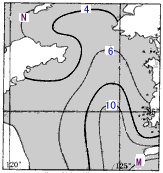问题
选择题
关于图示海域的说法正确的是

A、等温线明显北凸是受海陆热力差异的影响
B、旅顺口区海域渤海一侧波光粼粼,黄海一侧“百里冰封”
C、该海域结冰会使等温线北凸幅度减小
D、渤海、黄海结冰海域海水的盐度会降低
答案
答案:C
关于图示海域的说法正确的是

A、等温线明显北凸是受海陆热力差异的影响
B、旅顺口区海域渤海一侧波光粼粼,黄海一侧“百里冰封”
C、该海域结冰会使等温线北凸幅度减小
D、渤海、黄海结冰海域海水的盐度会降低
答案:C